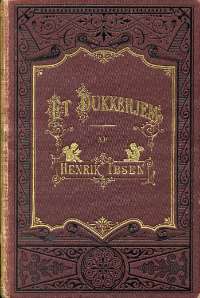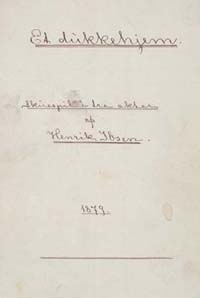

Brief description
The earliest notes for A Doll's House are dated 19 October 1878, just after Ibsen had moved from Munich to Rome. Under the heading «Notes for the contemporary tragedy» he writes:
There are two kinds of spiritual laws and two kinds of consciences – one for men and one for women. They do not understand each other, but in the practical matters of life women are judged by men's law, as if they were not women, but men. In the end the wife in the play is at a loss to know what is right and what is wrong; she is totally confused by natural feelings on the one hand and belief in authority on the other.
[see the note in original handwriting]
Ibsen knew of what was called the Laura Kieler affair, and this played some part in his drawing up of the dramatic conflicts in the play. Laura Smith Petersen – her later married name was Kieler – had had a novel published in 1869. The title was Brand's Daughters: a Picture of Life, and it was a kind of sequel to Ibsen's Brand. The following year she got to know Ibsen and the two of them became friends. She visited him in Dresden in 1871 and five years later – with her husband Victor Kieler – in Munich.
In 1876, Victor Kieler developed tuberculosis and his doctor advised a stay in a more southern climate. Unknown to her husband, Laura Kieler borrowed money to finance this, but gradually got into such trouble with her creditors that, like Nora, she committed forgery in order to get hold of money.
The affair ended in tragedy as the forgery was discovered, her husband demanded a divorce, her children were taken away from her, and the strain on her nerves led to her being committed to a mental hospital for a time. Ibsen knew about all this when he was working on A Doll's House.
The first complete draft of the play was started on 2 May 1879. Ibsen made changes continually, even when working on the fair copy, which was completed in mid-September. The finished manuscript was sent to Frederik Hegel from Amalfi. On 6 October 1879, Ibsen left Amalfi to return to Munich.
A Doll's House came out on 4 December 1879 at Gyldendalske Boghandels Forlag (F. Hegel & Søn) in Copenhagen. The first edition comprised 8 000 copies, the largest edition so far of Ibsen's works. The book was a sensational success, and the first edition was sold out in less than a month. A fresh issue of 4 000 copies came out on 4 January 1880 and a third of 2 500 copies on March 8th the same year.
A Doll's House became the object of intense debate, both publicly and in private, and was Ibsen's first international success, with which he entered the sphere of world literature.
The first performance of A Doll's House took place at Det Kongelige (Royal) Teater in Copenhagen on 21 December 1879. The production was sold out and a great success. The parts of Nora and Torvald were played by Betty Hennings and Emil Poulsen, and the director was H. P. Holst.
In the course of two months the play was staged at all the main theatres in the Scandinavian countries: on 8 January at Dramaten in Stockholm, 20 January at Christiania Theater, 30 January at Den nationale Scene in Bergen and on 25 February at Finland's national theatre in Helsingfors. On the Continent, Germany was first, with productions at a number of theatres during 1880.
(From ibsen.net)
Plot summary
Nora Helmer is apparently happily married to Torvald, a lawyer who is about to take over the post of director of the Joint Stock Bank. They have three small children. Nora has a secret to keep, however. Early in their marriage Torvald became seriously ill, and the doctors advised a stay in a more southern climate. Nora had to get hold of the money for the journey in secrecy and so borrowed it from Krogstad, a lawyer who had been a fellow-student of Torvald's. As security for the loan she forged her dying father`s signature. Ever since then she has saved some of the housekeeping money in order to pay back the loan with interest, and she has taken on small jobs to earn some money herself.
When the play opens, an old friend of Nora's, Mrs. Linde, has arrived in town to look for work, and Nora sees to it that Torvald gives her a post at the bank. But this means that Krogstad is dismissed from his post at the bank, and in desperation he goes to Nora and threatens to tell Torvald about the loan and the forgery unless he is allowed to keep his post. Nora is in despair but at the same time convinced that in his love for her, Torvald will sacrifice himself and take full responsibility for what she has done, if he learns the truth. Nora considers asking Dr. Rank, an old friend of the family, for the money, but when he declares his love for her, she finds it impossible to ask him.
Torvald finds out what has happened, and reacts with rage and revulsion, without any sign of being willing to accept responsibility for the forgery. Mrs. Linde, who was in love with Krogstad in the past, gets him to change his mind and withdraw his threats. But Nora has begun to understand that her marriage is not what she thought it was, and in the course of a dramatic conversation with Torvald she decides that her most important and only task is to go out into the world on her own to «bring herself up», and she leaves her husband and children.
(Source: Merete Morken Andersen, Ibsenhåndboken, Gyldendal Norsk Forlag, 1995.)
Read A Doll's House (in Norwegian)
In the online version of the official Ibsen edition (HISe) you can read A Doll's House in various formats. This content is currently only available in Norwegian. Follow the links below to read the play:
Introduction to the work (in Norwegian)
The online version of the official Ibsen edition (HISe) offers extensive information about A Doll's House in Norwegian. Follow the links below to read about various aspects connected to the play.
- Background
- Creative process
- About the publication
- Translations in Ibsen's life time
- Stagings in Ibsen's life time
- Ibsen's alternative ending (in German)
- More information
Reviews
Here you can find reviews in full text and an overview of registered reviews in various languages.
- Reviews from Ibsen's life time in full text
- Reviews registered in the Ibsen bibliography (nb.no)
- Reviews registered in "Norsk litteraturkritikk" (UiO)
Translations
- The Multilingual Ibsen
- Translations in various languages
- Overview of translations from Ibsen's lifetime (HISe)